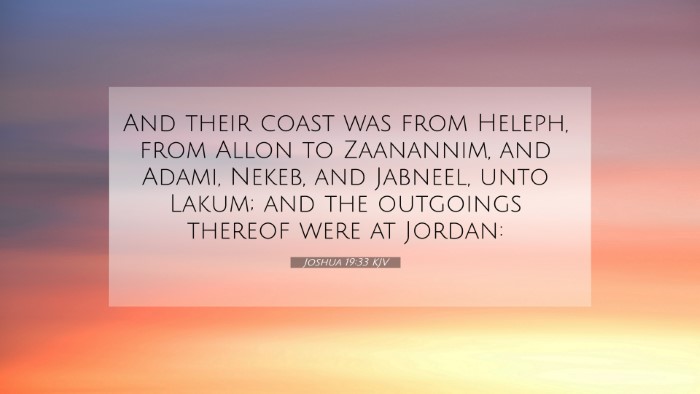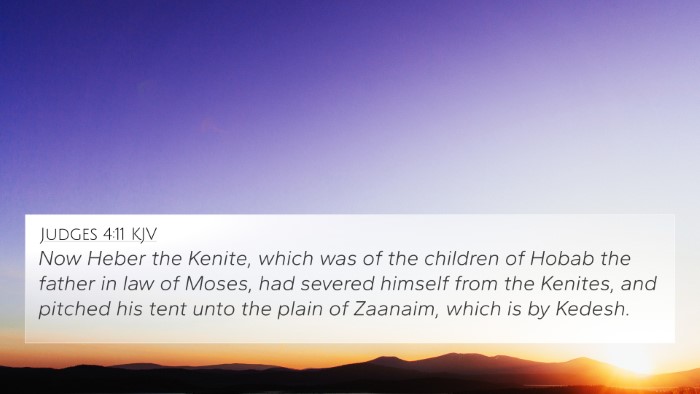Understanding Joshua 19:33
Joshua 19:33 reads: “And it went out from Heleph, all the way to the brook of Egypt, and the goings out of that coast were at the sea.” This verse is part of the enumeration of the territorial boundaries allotted to the tribe of Naphtali. The historical and geographical details presented hold significant implications for understanding Israel's tribal divisions.
Contextual Analysis
This verse highlights the detailed geographical allocations made during the conquest of Canaan under Joshua’s leadership. It serves to signify the promissory fulfillment of land inheritance, reflecting God's faithfulness to the Israelites. The delineation of boundaries is crucial for the establishment of social and religious order among the tribes of Israel.
- Faithfulness of God: This verse exemplifies the faithfulness of God to His promises, as seen in previous passages such as Exodus 23:30 and Deuteronomy 1:8.
- The significance of territory: The emotional and spiritual resonance of land allocation is highlighted in Leviticus 25:23, which emphasizes that the land ultimately belongs to God.
- Historical fulfillment: Joshua 14:1-2 shows the prior promises made to Abraham regarding land, fulfilling God's covenant with His people.
Insights from Commentaries
Matthew Henry: Henry elucidates that the boundaries defined here were not merely geographical markers; they served as a reminder of God’s promises and the historical journey of the Israelites. The detailed description indicates the divine order and intent behind each allocation. Furthermore, it instills a sense of identity among the tribes.
Albert Barnes: Barnes expands this interpretation by emphasizing the precise locations mentioned, suggesting that these details rooted the spiritual history of Israel in its physical landscape. This relationship between geography and theology reinforces the notion that God’s dealings with His people are tangible and historically anchored.
Adam Clarke: Clarke notes the reference to the brook of Egypt, shedding light on the geopolitical significance. This mention roots the tribe of Naphtali within not just local but wider historical narratives, showing their interactions with neighboring nations.
Cross-References of Joshua 19:33
- Numbers 34:6-7: Discusses the northern boundaries prescribed for the tribes.
- Deuteronomy 3:3: Highlights battles that set the stage for the land divisions.
- Joshua 17:10: Another instance of boundary delineations, emphasizing the territorial specifics required.
- Exodus 23:31: Documents God's promise of land to Israel and the geographic scope of His covenant.
- Genesis 49:21: Jacob’s prophecy about Naphtali and their future, connected to the themes of identity and promise.
- Joshua 14:3-4: Establishes the distribution among the tribes, prophesying future inheritances.
- Ezekiel 48:1-29: Envisions the future of Israel's land and the promise of restoration.
Thematic Connections
This verse invites examination of the following themes:
- Divine Inheritance: Reflects on the concept of land as a divine inheritance given to God’s chosen people.
- Covenantal Promise: Ties the current event to the overarching narrative of God’s faithfulness through generations.
- Geopolitical Significance: Emphasizes interactions with other nations, important in understanding Israel’s history.
Conclusion
In summary, Joshua 19:33 serves as a profound reminder of God’s faithfulness in fulfilling His promises through tangible historical events. The boundaries described are not merely limits; they represent the identity, history, and divine relationship of the Israelites with God. As we explore cross-references and thematic connections, we gain a fuller understanding of the scriptural interplay and the significance of land in God’s redemptive plan.
For Further Study
To delve deeper into the connections between Bible verses such as Joshua 19:33 and other scriptures, one may utilize tools for Bible cross-referencing, Bible concordances, or Bible reference resources that facilitate a better understanding of scripture in relation. Connecting Old and New Testaments or identifying detailed thematic cross-references can enrich one’s study and offer a more comprehensive biblical perspective.



